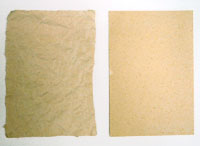
|
What's Nonwood Paper? |
||||
Nonwood paper is paper that's not made from the pulp of felled trees. Strictly speaking, washi - which has been around for centuries - is a kind of nonwood paper, but the term usually applies to common, everyday paper made from new sources, such as kenaf (a fiber crop that grows much faster than forest timber), bagasse (the part of the sugar cane that's left after the juice has been extracted), and banana stalks. Nonwood paper has been attracting attention recently because it is good for the environment. If we continue to rely on more and more paper made from wood chips, trees may have to be cut down just to make paper, and this would damage forests around the world. Forests are home to many different species of plants and animals. They also absorb carbon dioxide, a gas that causes global warming, and thus have a very important role in maintaining a balanced environment (click here to learn about greenhouse gases and global warming). If forests are destroyed, a lot of living organisms will die, and the earth will get warmer. Using nontraditional materials - including plant residues that have been discarded after harvest - to make paper will help to stop the destruction of forests. And labeling nonwood products as environmentally friendly can also boost consumers' awareness of the need to conserve forest resources. Photos: Superior Pulp Promotion Association | |||||
< Back to previous page | Go to next page >
